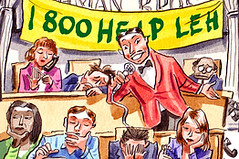 Image by mtlin via FlickrHoward Lindzon
Image by mtlin via FlickrHoward Lindzon
I have never woken up to bigger gains in my portfolio and they have never been less deserved.
If I had not taken the time to buy some stocks into the mess from the golf course yesterday and cover most of my shorts, this morning would make this one of the worst.
I would not have deserved that either.
Treasury Sec. Henry Paulson’s multi-billion dollar market rescue includes four things to save the market: Creating a toxic waste fund for worthless mortgage assets, extending the Fed’s discount window to investment banks, using a $50 billion Depression-era Exchange Stabilization Fund to guarantee money market investments, and installing a temporary ban on short-selling 799 financial stocks.
….
As for a short-sale ban—this isn’t the first time that SEC Chairman Christopher Cox has proposed one under a measure provided by the 1934 Securities Exchange Act. After four months of deliberating the role that short selling might have played in the pummeling of Bear Stearns’ stock, he installed a 10 day short-sale ban, between July 21st and 29th. That didn’t work for long.
But, sort of like with Sarah Palin and the bridge to nowhere, before he was against short selling, he was for it. Last year, the SEC removed a post 1929 stock market crash rule that only allowed short selling when the stock price’s last tick was positive, which was designed to prevent the kind of short selling he’s concerned about now.
…..
…Central Banks around the world are lavishing cash on the financial industry to keep liquidity alive. Today, Japan, Australia, India and Indonesia pumped $42 billion into their money markets, a day after the US Federal Reserve pushed through an $180 billion package. The Bank of England, Swiss National Bank, and European Central bank lent $70 billion of cash to their markets.
At the center of what turned into a highly unsound feeding frenzy were Freddie Mac and Fannie Mae, ostensibly private companies but ones where the leadership were politically appointed. Basically, these two institutions were run by political hacks from both parties, feeding the mortgage industry with billions of dollars earmarked for loans to those who previously didn’t qualify for home ownership.
Around 2003, Fannie/Freddie admitted that their financial statement couldn’t be relied upon, and it’s not clear that they ever put them in order since. There were several proposals from The White House in recent years to change this system drastically, but efforts to do so were rebuffed by Congress and in particular Chris Dodd and Barney Frank. As long as home prices kept rising, these highly unsound practices didn’t bother most people. In fact, the companies who originated the mortgages managed to sell them to Wall Street firms such as Bear Stearns and Lehman Brothers (LEH), who were looking to obtain higher yields on their proprietary trading portfolios. Leveraging up over 30:1, this became very profitable for those firms, until the bubble burst. Remember, at 30:1 leverage, you are bankrupt at as soon as losses exceed 3%.
Edward S. Lampert, the hedge fund tycoon who controls Sears Holdings, worries about yet another twist. He says the current wave of federal intervention sends the opposite signal from what’s intended: that officials are panicking because of broader instability. “As an investor, that was my immediate reaction” to the Fannie and Freddie moves, he says. “They completely destroyed confidence in any financial institution.”
Lampert frets that with investment banks failing and merging, the resulting consolidation will concentrate risk and invite more rescues. “You are going to have Citi, JPMorgan, and Bank of America with $2 trillion-plus in assets each,” he notes. “That’s three times the size of Fannie and Freddie. Now if they end up with problems, what do you think is going to happen? They are too big to fail.”


Another great article: http://tinyurl.com/4m2b2w